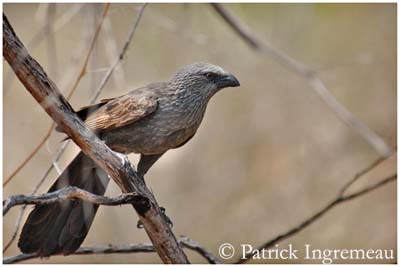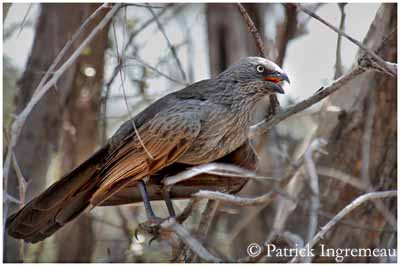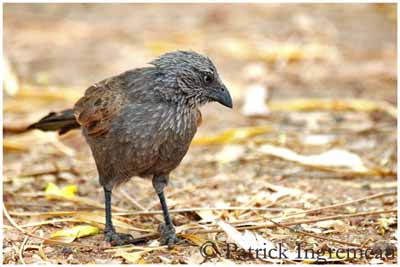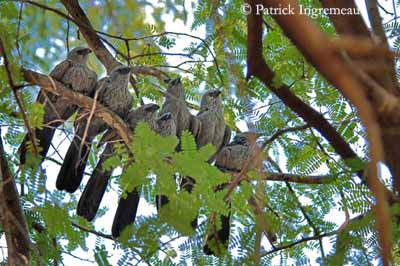
Apostlebird
Struthidea cinerea
Passeriforme Order – Corcoracidae Family
BIOMETRICS:
Length : 29-33 cm
Weight : 130 g
LONGEVITY: Up to 25 years
DESCRIPTION:
Apostlebird’s name comes from its family behaviour. This bird lives in groups often named « Happy family » or « Twelve Apostles ».
Fr: Apôtre gris
All : Gimpelhäher
Esp : Ave Apóstol
Ital : Uccello dei dodici apostoli
Nd : Apostelvogel
Russe : Штрутидеа
Photographs by Patrick Ingremeau
TAMANDUA
Text by Nicole Bouglouan
Sources:
Wikipedia (Wikipedia, The Free Encyclopedia)
Birds in backyards (Birds Australia and Australian Museum)
CREAGUS@Monterey Bay (Don Roberson)
Arthur Grosset's Birds (Arthur Grosset)
Animal Diversity Web (University of Michigan Museum of Zoology)

Adult has grey plumage, but wings are mostly brown, and long tail is black with glossy green shine. Its grey plumage is finely sprinkled with whitish small spots on feathers tips, mainly on head, mantle, throat and breast.
Heavy bill is black. Eyes are dark brown. Legs and feet are blackish.
Both sexes are similar.
VOICE: SOUNDS BY XENO-CANTO
Apostlebird usually utters discordant and scratchy “ch-kew, ch-kew” or “kreech”. When alarmed or disturbed, it gives a nasal “git-out”.

HABITAT:
Apostlebird lives near water, in woodlands and open dry forests. It also frequents disturbed areas such as farmlands with scattered trees, orchards, golf courses and roadsides.
RANGE:
Apostlebird lives in the eastern parts of Australia. Small population is found in Northern Territory, in Elliott and Katherine areas. It is often seen in open dry eucalypt woodlands in eastern and south-eastern of the continent. This species does not extend to the coast.
BEHAVIOUR:
Apostlebird forages mainly on the ground, and it often feeds in groups, searching for insects and seeds.

It is sedentary in its range, but we can see groups between 6 and 20 birds travelling together in autumn and winter to more open countries. At this season, they eat more seeds which are an important part of their diet.

It is often associated with White-winged Chough which is very similar to Apostlebird, but it has black plumage and white panels on wings, and longer curved bill.

Apostlebird is very social and gregarious. All members of the group share feeding, nest building, nesting duties and seasonal movements.
Number of birds in each group is related to number of young that survived in each brood, and can help adults in the following season.
Usually, contributions vary, according to age and sex of each member. Older birds are more active than yearlings, and male helpers incubate less than females or breeding pair. Males provide more food than females.
Apostlebird is also known as “Lousy Jacks” because this bird suffers heavy louse infestation. It is commonly seen dust-bathing on roadsides and other dry areas, probably for cleaning its plumage.
FLIGHT:
Apostlebird performs rapid flight.
REPRODUCTION:
Breeding season occurs from August to March.
Nest is situated on horizontal branch at about 3 to 20 metres above the ground. Nest is bowl-shaped, made with mud mixed with grasses, and interior is lined with softer grasses. It is built by all members of the group.

Female lays 2 to 5 eggs, but several females can lay in the same nest. Incubation lasts about 18 days, shared by parents and helpers, according to age and sex.
All members feed the chicks, but usually, even with many eggs, only 4 nestlings can survive.
Young fledge about 18 days after hatching.
This species can produce two broods per season.

DIET:
Apostlebird feeds mainly on insects and seeds, but also other vegetable items, and sometimes small vertebrates such as mice.
PROTECTION / THREATS / STATUS:
Apostlebird is relatively common in its range, and numbers seems to be stable and secure.